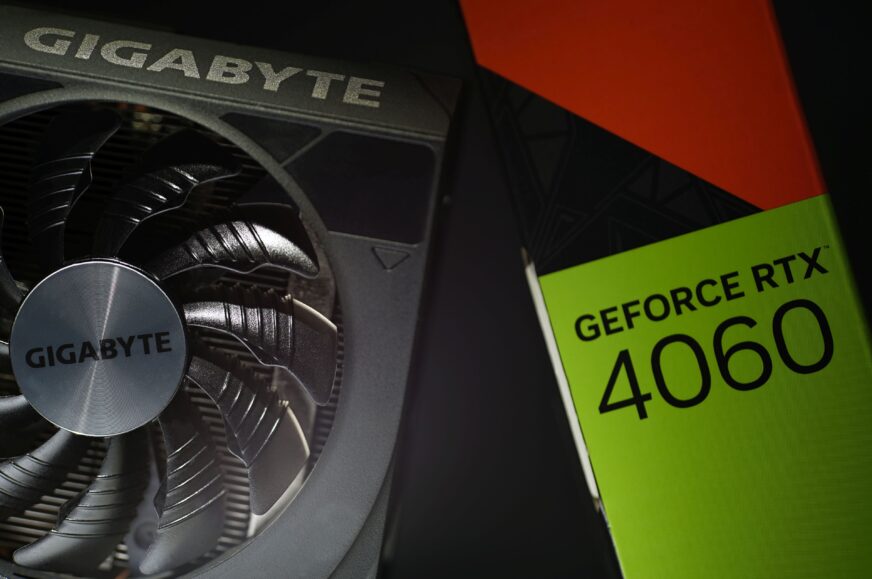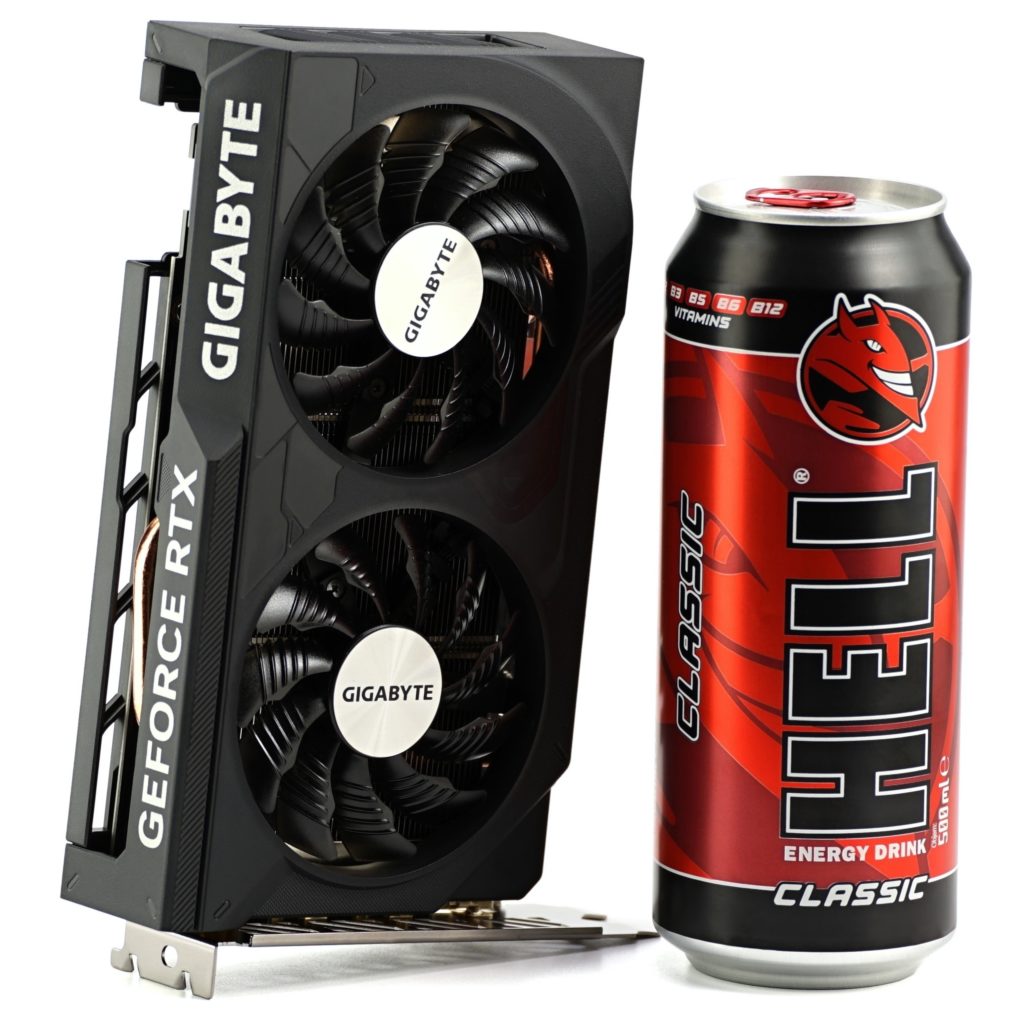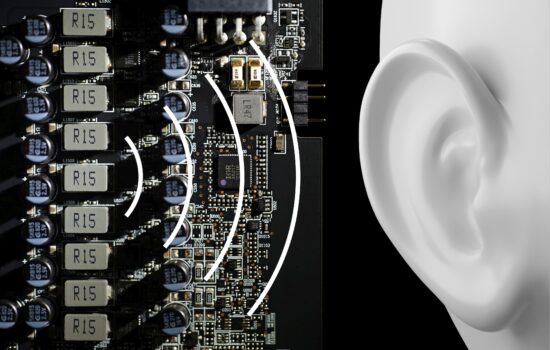Table of parameters
Catching up where we’re behind, we come to the GeForce RTX 4060. Across designs, these graphics cards represent not only the most efficient and lowest-power across the latest generation of Nvidia Ada Lovelace, but overall (i.e., even compared to the latest Radeons, including the competing RX 7600). The advantage of the tested (RTX 4060) Windforce OC 8G design is in its smaller size and extra compatibility.
We covered the Gigabyte RTX 4060 Windforce OC 8G graphics card in part back in June, on the day of its release. However, by a confluence of unfortunate circumstances, its tests did not take place and the focus was only on design details. These can be found in an earlier article and will not be revisited here. That is, in terms of their overview. In the context of the evaluation, which is traditionally in the final chapter, we will not deprive you of referring to the influence of certain elements (especially the cooler).
| Parameters | Gigabyte RTX 4060 Windforce OC 8G | |
| Asus Dual RTX 4070 12G | ||
| Architecture | Ada Lovelace | |
| Die | AD107-400-A1 | |
| Manufacturing node | 4 nm TSMC | |
| Die size | 190 mm² | |
| Transistor count | 22.9 bn. | |
| Compute units | 24 | |
| Shaders/CUDA cores | 3072 | |
| Base Clock | 1830 MHz | |
| Game Clock (AMD) | – | |
| Boost Clock | 2475 MHz | |
| RT units | 24 | |
| AI/tensor cores | 96 | |
| ROPs | 48 | |
| TMUs | 93 | |
| L2 Cache | 24 MB | |
| Infinity Cache | – | |
| Interface | PCIe 4.0 ×8 | |
| Multi-GPU interconnect | – | |
| Memory | 8 GB GDDR6 | |
| Memory clock (effective) | 17.0 GHz | |
| Memory bus | 128 bit | |
| Memory bandwidth | 272.0 GB/s | |
| Pixel fillrate | 118.1 Gpx/s | |
| Texture fillrate | 236.2 Gtx/s | |
| FLOPS (FP32) | 15.11 TFLOPS | |
| FLOPS (FP64) | 236.2 GFLOPS | |
| FLOPS (FP16) | 15.11 TFLOPS | |
| AI/tensor TOPS (INT8) | 121 TOPS | |
| AI/tensor FLOPS (FP16) | 60 TOPS | |
| TDP | 115 W | |
| Power connectors | 1× 8-pin | |
| Card lenght | 192 mm | |
| Card slots used | 41 mm | |
| Shader Model | 6.7 | |
| DirectX/Feature Level | DX 12 Ultimate (12_2) | |
| OpenGL | 4.6 | |
| Vulkan | 1.3 | |
| OpenCL | 3.0 | |
| CUDA | 8.9 | |
| Video encoder engine | NVEnc 8 | |
| Encoding formats | HEVC, H.264, AV1 | |
| Encoding resolution | 8K | |
| Video decoder engine | NVDec 5 | |
| Decoding formats | HEVC, H.264,VP9, AV1 | |
| Decoding resolution | 8K | |
| Max. Monitor resolution | 7680 × 4320 px | |
| HDMI | 1× (2.1) | |
| DisplayPort | 3× (1.4a) | |
| USB-C | – | |
| MSRP | 349 EUR |
- Contents
- Table of parameters
- Methodology: performance tests
- Methodology: how we measure power draw
- Methodology: noise and sound measurement
- Methodology: temperature tests
- Test setup
- 3DMark
- Age of Empires II: DE
- Assassin’s Creed: Valhalla
- Battlefield V
- Battlefield V with DXR
- Borderlands 3
- Control
- Control with DXR and DLSS
- Counter-Strike: GO
- Cyberpunk 2077
- Cyberpunk 2077 with DLSS
- Cyberpunk 2077 with DXR (and DXR with DLSS)
- DOOM Eternal
- F1 2020
- FIFA 21
- Forza Horizon 4
- Mafia: DE
- Metro Exodus
- Metro Exodus with DXR and DLSS
- Microsoft Flight Simulator
- Red Dead Redemption 2 (Vulkan)
- Red Dead Redemption 2 (Dx12)
- Shadow of the Tomb Raider
- Shadow of the Tomb Raider with DXR
- Total War Saga: Troy
- Wasteland 3
- Overall gaming performance and performance per euro
- CompuBench (OpenCL)
- SPECviewperf 2020 and SPECworkstation 3
- FLOPS, IOPS and memory speed tests
- 3D rendering 1/2 (LuxMark and Blender@Cycles)
- 3D rendering 2/2 (Blender@Radeon ProRender and Eevee)
- Photo editing (Adobe Photoshop, Lightroom and Affinity Photo)
- Broadcasting (OBS and Xsplit)
- Password cracking
- GPU clock speeds
- GPU and VRAM temperatures
- Net graphics card power draw and performance per watt
- Analysis of 12 V branch power supply (higher load)
- Analysis of 12 V branch power supply (lower load)
- Analysis of 3,3 V branch power supply
- Noise level
- Frequency response of sound
- Conclusion













Perhaps I remembered wrongly, but I thought the analysis section was a bit different (on the size of the cooler and heatpipes)?
Anyway, it’s a shame that this model has such poor thermal performance. The fin stacks looks ok, the fans look fine, so the most likely culprit is indeed the lack of a second heatpipe. The similarly sized MSI Ventus 2X is much better in comparison.
The fans are smaller, with a diameter of 80 mm and a profile height of 10 mm. The heatsink is lower, the cooler with the cover fits comfortably into two slots. The heat pipe has a diameter of 6 mm, its path is well visible from the TechPowerUp tests. We don’t disassemble graphics cards, so that the next reviewer in line, who will test the sample, can also measure the correct (undistorted) values.